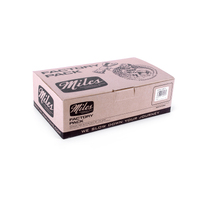These replacement Formula brake pads can be used in the following:
FORMULA
- Formula Mega
- The One
- R1
- RO
- RX
- T1
Each set includes pads and a spring to replace the brake pads on one caliper.
Different Types of Disc Brake Pad Compounds
Typically you'll find that there are three types of compounds to choose from when buying new brake pads for your disc brake equipped bike. They are:
- Organic
- Semi-Metallic
- Sintered
Each of these brake pad compounds will provide a different feel during braking. You'll also find that one compound may last longer compared than another depending on the type of rider you are and the amount to which you use your brakes.
What compound should I choose?
Choosing a compound ultimately depends on the type of riding you are doing. In most cases a semi-metallic pad will exceed the needs of most riders because it combines the durability of sintered with the feel of organic compounds. To make sure you're getting the best pad for your riding style, review the benefits of each below.
Semi-Metallic Brake Pads
Semi-metallic brake pads are an all-round solution for most common conditions, where brakes are not getting extremely hot. They work best for dirt jumping, cross country and lighter enduro rides with shorter downhill segments. They'll even be more than capable for downhill riders who aren't standing on the brakes all the way down, or for lighter riders.
With a high percentage of iron and copper added to the resin in the compound, semi-metallic pads offer a longer life and more heat resistance compared to organic disc brake pads. The metal compounds add longevity and the resin allows for the pad to have high friction against the brake rotor right away.
Because of this, you'll notice semi-metallic brake pads have a stronger initial bite when you begin to pull the brake lever. If you prefer your brakes to grab and feel strong from the start, semi-metallic pads should be your first choice.
| SEMI-METALLIC PAD PROS | SEMI-METALLIC PAD CONS |
| - Great initial bite | - Wears faster than sintered |
| - Easy to break-in | - Not ideal for adverse conditions (wet, mud, etc.) |
| - Quieter |
Sintered Brake Pads
Sintered pads, also known as metal or metallics, are brake pads that are completely made up of hardened metal, bonded together with high heat and pressure. There are no resins present in sintered brake pads making them much more durable than a semi-metallic or organic pad.
Sintered disc brake pads are perfect for larger riders, braking on steeper descents, or riders who have had to deal with brake fade issues. While the initial bite of sintered brake pads are not as strong as semi-metallic or organic compounds, they can handle way more heat.
Sintered brake pads also provide a more consistent feel and can be easily modulated, giving your brakes a progressive feel at the lever, rather than only being on or off.
Sintered pads also shine across a wider range of conditions. They are less likely to be effected by dust, mud, or water than other pad types.
| SINTERED PAD PROS | SINTERED PAD CONS |
| - Longer lifespan | - Longer break-in period |
| - Work better in all conditions | - Lower initial bite |
| - Fade at higher temperatures |
| SKU | MI-PAD-53 |
| Brand | Miles Racing |
Be The First To Review This Product!
Help other CTN Bike users shop smarter by writing reviews for products you have purchased.

















